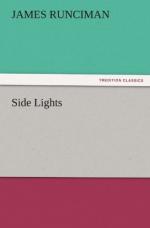principle is the same. When the woman settles
in her new home, she is free from sordid anxieties,
and she can give the graces of her mind play.
How beautiful some such households are! An old
railway-guard once said to me—“Ah,
there’s no talk like your own wife’s when
she understands you, and you sit one side of the fire,
and she the other! It don’t matter what
kind of day you’ve had, she puts all right.”
The man was right—the most delightful conversation
that can be held is between a rational man and woman
who love each other, who understand each other, and
who have sufficient worldly keenness to keep clear
of lowering cares. A man rightly mated feels
it an absolute delight to confide the innermost secrets
of life to his wife; and the woman would feel almost
criminal if she kept the pettiest of petty secrets
from her partner. They are friends, gloriously
mated, and all the glories of birth and state ever
imagined cannot equal their simple but perfect joy.
When the tired mechanic comes home at night and meets
one whom he has wisely chosen, he forgets his sharp
day of labour as soon as his overalls are off.
No snappish word greets him; and he is incapable of
being ill-natured with the kind soul whom he worships
in his rough way. I have always found that the
merriest and most profitable evenings were passed
in houses where neither of the principal parties strove
for mastery, and where the woman had the art of coaxing
imperceptibly and discreetly. I reject the suggestion
made by cynic men that no married pair can live without
quarrelling. No married pair who were fools before
marriage can avoid dissension; but, when man and wife
make their choice wisely and cautiously, the notion
of a quarrel is too horrible to dream of.
IX.
SHREWS.
The greatest masters who ever made studies of the
shrew in fiction or in history have never, after all,
given us a strictly scientific definition of the creature.
They let her exhibit herself in all her drollery or
her hatefulness, but they act in somewhat lordly fashion
by leaving us to frame our definition from the picturesque
data which they supply. Mrs. Mackenzie, in “The
Newcomes,” is repulsive to an awful degree,
but the figure is as true as true can be, and most
of us, no doubt, have seen the type in all its loathsomeness
only too many times. Mrs. Mackenzie is a shrew
of one sort, but we could not take her vile personality
as the basis of a classification. Mrs. Raddle
is one of that lower middle-class which Dickens knew
so well, still she is not hateful or vile, or anything
but droll. I know how maddening that kind of
woman can be in real life to those immediately about
her, but onlookers find her purely funny; they never
think of poor Bob Sawyer’s cruel humiliation;
they only laugh themselves helpless over the screeching
little woman on the stairs, who humbles her wretched
consort and routs the party with such consummate strategy.




